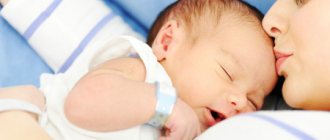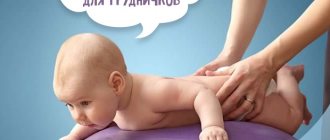Hip dysplasia in newborns (infants)
Hip dysplasia is a congenital defect of the joint that can lead to joint damage. Dysplasia in newborns is the direct cause of congenital hip dislocation. This pathology, in turn, can lead to changes in gait, chronic pain syndrome and significantly limit mobility in the future.
The newborn itself (a newborn is a child in the first 28 days of life) is not bothered by dysplasia; Parents and doctors identify the disease based on external symptoms, and not on the basis of the baby’s crying or restlessness. If the pathology is not treated on time, it leads to deformation of the musculoskeletal system, disruption of the formation of the musculoskeletal system and disability. The disease can affect one leg (usually) or both. Boys suffer from hip dysplasia 7 times less often than girls.
What it is?
Today, hip dysplasia is considered the most common pathology of the musculoskeletal system in newborns and infants. “Dysplasia” translated means “improper growth,” in this case of one or both hip joints.
The development of the disease is associated with disruption of the formation of the main joint structures in the prenatal period:
- ligamentous apparatus;
- bone structures and cartilage;
- muscles;
- change in the innervation of the joint.
Most often, hip dysplasia in newborns and the treatment of this pathology is associated with a change in the location of the femoral head in relation to the bony pelvic ring. Therefore, in medicine this disease is called congenital hip dislocation.
Treatment must begin from the moment the pathology is diagnosed, the earlier the better, and before the baby begins to walk - from this moment irreversible complications appear. They are associated with an increasing load on the joint and the exit of the bone head completely from the acetabulum with an upward or sideways displacement.
The child develops changes when walking: a “duck” gait, significant shortening of the limb, compensatory curvature of the spine. These disorders can only be corrected through surgery. With pronounced changes in the joint, the baby may remain disabled for life.
Symptoms of dysplasia in children under one year old
Signs of the disease can be detected in an infant in the first month of life. Mom can do the testing herself. To do this, the newborn needs to be placed, preferably on the table. Make sure that he is in a good mood, does not cry or be capricious - this may distort the result.
Upon examination, you will notice the following symptoms:
- Various folds on the buttocks and thighs when lying on the stomach. Folds differ in depth, length, level of location;
- Turn the baby onto his back. Bend your knees. Pay attention to the level at which your knees are: they should be the same;
- Spread your legs to the sides. In a healthy infant, they are given the same way.
We were just talking about unilateral dysplasia. If there is a violation on both sides, you will not notice the difference. In this case, the click symptom, or Marx-Ortolani symptom, will help you figure it out. The baby lies on his back, you bend and spread your legs. When the hip joint is unstable, a click is heard, which occurs at the moment of dislocation and reduction of the femoral head into the acetabulum.
An older child, if his pathology is not diagnosed, walks “on his tiptoes”, he develops clubfoot, and his toes turn out. He may also stoop, and various forms of postural disturbances arise and progress.
The detected signs are not the basis for the mother to make a diagnosis. If you find deviations, this is just a reason to consult an orthopedic doctor. The diagnosis is made solely on the basis of examination.
Statistics
Hip dysplasia is common in all countries (2 - 3%), but there are racial and ethnic characteristics of its distribution. For example, the incidence of congenital underdevelopment of the hip joints in newborn children in Scandinavian countries reaches 4%, in Germany - 2%, in the USA it is higher among the white population than African Americans, and is 1 - 2%, among American Indians, hip dislocation occurs in 25- 50 per 1000, while congenital hip dislocation almost never occurs among South American Indians, southern Chinese and Africans.
A connection between morbidity and environmental problems has been noted. The incidence in the Russian Federation is approximately 2 - 3%, and in environmentally unfavorable regions up to 12%. Statistics on dysplasia are contradictory. Thus, in Ukraine (2004), congenital dysplasia, subluxation and dislocation of the hip occur in 50 to 200 cases per 1000 (5 - 20%) newborns, that is, significantly (5-10 times) higher than in the same territory during the Soviet period.
A direct connection has been noted between the increased incidence and the tradition of tightly swaddling the baby's straightened legs. Among peoples living in the tropics, newborns are not swaddled, their freedom of movement is not limited, they are carried on their backs (while the child’s legs are in a state of flexion and abduction), the incidence is lower. For example, in Japan, as part of a national project in 1975, the national tradition of tightly swaddling the straightened legs of infants was changed. The training program was aimed at grandmothers to prevent traditional swaddling of babies. As a result, there was a decrease in congenital hip dislocation from 1.1-3.5 to 0.2%.
This pathology occurs more often in girls (80% of identified cases); family cases of the disease make up about a third. Hip dysplasia is 10 times more common in children whose parents had signs of congenital hip dislocation. Congenital dislocation of the hip is detected 10 times more often in those born with a breech presentation of the fetus, more often during the first birth. Dysplasia is often detected during drug correction of pregnancy, or during pregnancy complicated by toxicosis. Most often the left hip joint is affected (60%), less often the right (20%) or both (20%).
Until the first half of the last century, only the severe form of dysplasia, congenital hip dislocation (3-4 cases per 1000 births) was taken into account. In those years, “mild forms” of dysplasia were not detected or treated. From the 70s - 90s. The term “hip dysplasia” is used, meaning not only dislocation, but also preluxation and subluxation of the hip joint. The incidence numbers have increased tenfold.
It should be noted that the lack of clear standards and the fear of missing severe orthopedic pathology is the reason for overdiagnosis (20-30% at the pre-dislocation stage). The dilemma of “immature hip joint and preluxation” is usually resolved in favor of dysplasia, which increases morbidity figures.
Other treatments
I do not use other methods used in other medical institutions, but I need to write about them to promote the article on the Internet:
- Pavlik stirrups. Used from 6-8 weeks to six months.
- Freyka pillow (up to 6 months).
- Lawrence reduction after skeletal traction with an immobilizing plaster cast (up to 2 years).
A surgical approach to the treatment of hip dysplasia in children is carried out in case of failure of conservative methods or late diagnosis after 2 years. Osteotomy according to Chiari and creation of the roof of the cavity according to Salter are used.
Hip dysplasia is perhaps the most common orthopedic pathology in children. If we look at the numbers, the incidence of the disease ranges from 2 to 16 per 1000 newborns. When the prevalence of congenital hip dislocation is 3-4 cases per 1000 normal births.
Hip dysplasia in children occurs in all countries, but there are some racial and ethnic differences in distribution. For example, the frequency in Scandinavian countries reaches 4%, in Germany – 2%, in the USA it is higher among the white population than among African Americans, and amounts to 1-2%. Among hereditary pathologies, up to 70-80% of cases are dysplasia.
When treated using the Nikonov method on muscles, the prognosis for this disease is favorable.
Doctor Nikonov
The number of unfavorable outcomes with other methods of treating hip dysplasia in children remains at a high level. After inadequate conservative treatment, up to 15-70% of children have residual developmental defects, and in 21-80% of cases deforming arthrosis is formed.
Hip dysplasia in a child diagnosed with cerebral palsy
Nikolai Borisovich Nikonov, the author of the technique of influencing muscles using the Nikonov method with fixation of the problem muscle, taught the parents of a small patient to put him in the “splits” and “frog” poses. Neither surgeons nor neurologists were able to achieve these results. A myologist with 30 years of experience applied his own scheme of influencing muscles using the Nikonov method, which is the most effective method in the treatment of hip dysplasia in children. Now parents, using the acquired knowledge, independently put the child in the “splits” and “frog” poses. In this case, one of the parents fixes the child’s legs and arms.
Let's consider another case from the practice of Nikolai Borisovich. Patient's diagnosis: dysplasia of both hip joints. Alena, the child’s mother, turned to a myologist with a request to restore movement in her son’s joints. At the same time, the baby had an additional aggravating diagnosis: cerebral palsy. But, despite this, Nikolai Borisovich Nikonov managed to perform another miracle! The author of the effect on muscles using Nikonov’s method put the child in the “split” and “frog” positions, which would seem impossible, according to classical medicine. Soon the baby will be completely healthy!
Treatment of cerebral palsy. Explanation of how to correctly bend from a lying position.
Do not attempt such bends without first relaxing your back muscles and oblique abdominal muscles.
Also, under no circumstances try to move and fix your arms in the “behind your head” position without preparation.
Nikolay Borisovich Nikonov, before starting serious exercises, first prepares the child’s muscles for impact on the muscles using Nikonov’s method with fixation of the problem muscle. Bending from a prone position is a preparatory exercise before the splits.
Causes of dysplasia
Underdevelopment and improper formation of the hip joint occur when the intrauterine development of a child is disrupted due to disturbances in the formation, development and differentiation of the baby’s musculoskeletal system (from 4-5 weeks of intrauterine development until the formation of full walking).
Reasons that negatively affect the fetus and disrupt organogenesis:
- gene mutations, as a result of which orthopedic deviations develop with disturbances of the primary anlage and the formation of defects in the hip joints of the embryo;
- exposure to negative physical and chemical agents directly on the fetus (ionizing radiation, pesticides, use of medications);
- a large fetus or breech presentation, causing displacement in the joints due to a violation of the anatomical norms of the location of the child in the uterus;
- disturbance of water-salt metabolism in the fetus due to kidney pathology and intrauterine infections.
Factors that negatively affect the development of the fetus and cause the formation of dysplasia on the mother’s side are:
- severe somatic diseases during pregnancy - cardiac dysfunction and vascular pathology, severe kidney and liver diseases, heart defects;
- vitamin deficiency, anemia;
- violation of metabolic processes;
- severe infectious and viral diseases suffered during pregnancy;
- unhealthy lifestyle, unhealthy diet and bad habits (smoking, drug addiction, drinking alcohol);
- early or late toxicosis.
In the risk group for the development of this pathology, contributing to the early diagnosis of dysplasia in infants. At the same time, even in the maternity hospital, the neonatologist and pediatrician at the site observe the baby more actively.
This group primarily includes premature babies, large children, with a breech presentation of the fetus, a pathological pregnancy and with a family history. It should be noted that this pathology occurs more often in girls than in boys.
Also, in addition to true dysplasia, infants (impaired development of the joint) may exhibit immaturity of the joint (slow development), which is considered a borderline state for the development of dislocation of the hip joint.
Indications for the procedure
It is recommended that all newborns undergo an ultrasound scan of the hip joints at least once, regardless of the presence of a predisposition to diseases of the hip joints or negative factors during pregnancy and childbirth.
A pediatrician or pediatric orthopedist may refer a child for an ultrasound of the hip joint for the following indications:
- different lengths of the legs, noticeable visually;
- clicking when hips move apart;
- hypertonicity of the lower extremities;
- limited mobility of the limb in the hip area;
- asymmetry of skin folds in the buttocks area;
- diagnosed arthritis.
Children who were born prematurely deserve special attention. If the pregnancy (especially multiple pregnancy) was difficult, there was a breech presentation, the newborns are at risk and need this type of diagnosis. Children whose parents suffered from similar diseases in childhood are also susceptible to developing pathologies of the hip joints.
Symptoms of dysplasia
When examining a baby, pay attention to the following signs (see photo):
- position and size of the lower extremities;
- position of skin folds in the thigh area (symmetrical or asymmetrical);
- muscle tone;
- volume of active and passive movements.
Hip dysplasia in infants manifests itself with characteristic symptoms.
- Limitation of hip abduction. Childhood hip dysplasia is manifested by limited abduction to 80 degrees or less. The symptom is most typical for unilateral lesions.
- Slipping symptom (synonym: clicking symptom). The child is placed on his back, bending his legs at both the knee and hip joints at an angle of 90 degrees (the examiner’s thumbs are placed on the inner surface of the thighs, the remaining fingers are on the outer surface). When the hips are abducted, pressure is applied to the greater trochanter, resulting in the reduction of the femoral head. The process is accompanied by a characteristic click.
- External rotation of the lower extremity is a sign characterized by outward rotation of the hip on the affected side. It can also occur in healthy children.
- Relative shortening of the limb. The symptom is rare in newborns and is observed with high dislocations.
- The asymmetrical position of the femoral and gluteal folds is revealed during an external examination.
Secondary (auxiliary) signs of hip dysplasia in a newborn:
- atrophy of soft tissues (muscles) on the affected side;
- pulsation of the femoral artery is reduced on the side of the dysplastic joint.
Asymptomatic cases of congenital hip dislocation are rare.
How does hip dysplasia manifest - symptoms and signs
Parents of an infant are able to themselves suspect the presence of hip dysplasia. Typical signs:
- shortening of the thigh;
- restrictions in hip abduction (in the supine position, the child’s legs, bent at the knee and hip joints, are moved apart, if an angle of less than 160° is formed between them, the likelihood of dysplasia is very high);
- “click” symptom (scientifically called the Marx-Ortolani symptom) - when you slowly open your bent legs, you may hear a click on the affected side. At the same time, the affected leg twitches a little.
- asymmetry of the skin inguinal, gluteal and popliteal folds - asymmetry is most pronounced in children older than 2 months.
Asymmetry of skin folds may be absent with bilateral lesions.
Severity of traffic accidents
- I degree – pre-dislocation. A developmental deviation in which the muscles and ligaments are not changed, the head is located inside the beveled cavity of the joint.
- II degree – subluxation. Only part of the femoral head is located inside the articulation cavity, as it moves upward. The ligaments are stretched and lose tension.
- III degree – dislocation. The head of the femur comes completely out of the socket and is located higher. The ligaments are tense and stretched, and the cartilaginous rim fits inside the joint.
Diagnostics
In a baby, signs of hip dysplasia in the form of a dislocation can be diagnosed in the maternity hospital. The neonatologist should carefully examine the child for the presence of such abnormalities in certain pregnancy complications.
The risk group includes children who belong to the category of large children, children with deformed feet and those with heredity burdened by this characteristic. In addition, attention is paid to toxicosis of pregnancy in the mother and the gender of the child. Newborn girls are subject to mandatory examination.
Examination methods:
- Ultrasound diagnostics is an effective method for identifying abnormalities in the structure of joints in children in the first three months of life. Ultrasound can be performed multiple times and is acceptable when examining newborns. The specialist pays attention to the condition of the cartilage, bones, joints, and calculates the angle of the hip joint.
- Arthroscopy and arthrography are performed in severe, advanced cases of dysplasia. These invasive techniques require general anesthesia to obtain detailed information about the joint.
- CT and MRI provide a complete picture of pathological changes in the joints in various projections. The need for such an examination appears when planning surgical intervention.
- The X-ray image is not inferior in reliability to ultrasound diagnostics, but has a number of significant limitations. The hip joint in children under seven months of age is poorly visible due to the low level of ossification of these tissues. Radiation is not recommended for children in their first year of life. In addition, placing an active baby under the device while maintaining symmetry is problematic.
- External examination and palpation are carried out to identify characteristic symptoms of the disease. In infants, hip dysplasia has signs of both dislocation and subluxation, which are difficult to identify clinically. Any symptoms of abnormalities require a more detailed instrumental examination.
How is hip joint diagnosis performed for newborns?
The child is placed on the couch. During the examination, the doctor turns him from one side to the other and moves the sensor in the groin area.
It is desirable that the child moves as little as possible during the examination, so an ultrasound is performed when the baby is healthy, does not suffer from colic and is generally calm. The child should be fed no later than half an hour before the examination.
During the diagnostic process, the doctor pays attention to:
- condition of joints and adjacent soft tissues;
- angles of the hip joints and their relationships;
- development of the bone dome of the acetabulum;
- development of the cartilaginous zone of the acetabulum.
An orthopedic surgeon interprets the results obtained. He assesses the condition of the joints, makes a conclusion about the presence or absence of pathologies and, if necessary, proposes a treatment regimen.
Consequences
If there is no treatment, then at an early age this can threaten the child with serious troubles. Children develop a limp when walking; it can be either barely noticeable or pronounced. Also, the baby will not be able to move his leg to the side, or will do it with great difficulty. The child will be bothered by constant pain in the knees and pelvis with possible bone distortion. Depending on the severity of the symptoms of dysplasia, children experience muscle atrophy of varying severity.
Gradually, as the child grows, the consequences of untreated dysplasia will worsen and be expressed in the development of the so-called “duck gait,” when the baby rolls from one leg to the other, protruding the pelvis back. The motor activity of such a child will be limited, which will entail underdevelopment not only of other joints, but will also affect the functioning of all organs and overall physical development. In the future, the leg muscles can completely atrophy, and the person will begin to be haunted by constant, incessant pain. In adult patients, hyperlordosis of the spine in the lumbar region is observed. All organs located in the pelvic area are also affected.
All this can be avoided if you start treatment on time and follow preventive measures.
Treatment of hip dysplasia in newborns
Modern conservative treatment of hip dysplasia in newborns is carried out according to the following basic principles:
- giving the limb an ideal position for reduction (flexion and abduction);
- start as early as possible;
- maintaining active movements;
- long-term continuous therapy;
- the use of additional methods of influence (therapeutic gymnastics, massage, physiotherapy).
It was noticed quite a long time ago that when the child’s legs are positioned in an abducted state, self-reduction of the dislocation and centering of the femoral head are observed. This feature forms the basis for all currently existing methods of conservative treatment (wide swaddling, Freik's pillow, Pavlik stirrups, etc.).
- Without adequate treatment, hip dysplasia in adolescents and adults leads to early disability, and the result of therapy directly depends on the timing of the start of treatment. Therefore, primary diagnosis is carried out in the maternity hospital in the first days of the baby’s life.
- Today, scientists and clinicians have come to the conclusion that it is inadmissible to use rigid fixing orthopedic structures that limit movement in abducted and flexed joints in infants under six months of age. Maintaining mobility helps center the femoral head and increases the chances of healing.
Conservative treatment involves long-term therapy under ultrasound and X-ray control.
Causes of the disease
The causes of the disease have not yet been fully elucidated.
A number of provoking factors and features can be identified.
- Hereditary predisposition
- national traditions of tight swaddling,
- breech presentation,
- taking medications during pregnancy,
- premature birth,
- heavy baby weight
- girls are more predisposed
- the left joint suffers more often,
- bad ecology.
Symptoms
The newborn must be examined by an orthopedist while still in the maternity hospital. Warning symptoms:
- asymmetry of the inguinal, popliteal and gluteal skin folds,
- knees are at different heights,
- legs move apart differently (limited movement),
- a characteristic “click” during slow movement of the legs in both directions.
Stages of dysplasia
Depends on the nature and degree of joint disorders.
- Physiological immaturity (underdevelopment) - joint surfaces are comparable correctly.
- Pre-luxation is a slight displacement of the femur, the ends of the joint fit normally.
- Subluxation (incomplete dislocation)—the femoral head moves during active movements, but does not extend beyond the boundaries of the glenoid cavity.
- True dislocation - the head of the femur comes out of the acetabulum (articular) cavity, an extreme degree of dysplasia, requires surgical treatment.
Complications
If, when examining a child, the doctor discovers any dysplastic disorders in the development and correct formation of the hip joint, it is necessary to begin treatment immediately, without waiting for complications to arise.
- The child begins to walk later
- unsteady gait;
- clubfoot and flat feet appear;
- possible lameness;
- there is a possibility of developing osteochondrosis.
Lack of timely treatment for even minor changes in childhood in the future can not only worsen the quality of life, but also lead to disability.
Diagnostics
Immaturity of the hip joints in a newborn baby is normal. To exclude the development of pathology, all children should be regularly examined by an orthopedist at 1, 3, 6 months and a year.
It is necessary to identify and treat dysplasia from the first months of life.
To make a correct diagnosis, in addition to an external examination, it is necessary:
- X-ray examination - performed after 3 months;
- Ultrasound is a safe way to assess the condition of all joint structures and can be performed at any age from the first days of life.
- CT and MRI may be required if surgery is being considered.
Wide swaddling of baby
Wide swaddling can rather be attributed not to therapeutic, but to preventive measures for hip dysplasia.
Indications for wide swaddling:
- the child is at risk for hip dysplasia;
- During an ultrasound scan, immaturity of the hip joint was revealed in a newborn child;
- there is hip dysplasia, while other treatment methods are impossible for one reason or another.
Wide swaddling technique:
- the child is placed on his back;
- two diapers are placed between the legs, which will limit the bringing of the legs together;
- These two diapers are fixed on the child’s belt with the third one.
Loose swaddling allows you to keep the baby's legs apart at approximately 60 - 80°.
Massage and exercise therapy
Exercises and massage are performed before feeding: these procedures stimulate blood circulation and improve nutrition of the structures of the hip joint. As a result, the growth processes of cartilage and bone tissue are stimulated, nerve conduction is enhanced - and the joint is formed correctly.
Massage movements are performed smoothly and gently. Apply stroking, rubbing and kneading the muscles of the thighs, buttocks, and lower back. The newborn is laid out on both his back and stomach. The duration of the massage is about 5 minutes. After the procedure, you can leave him to lie on his stomach for some time so that his legs hang down to the sides. This hardens and further strengthens the body.
A set of exercises is selected by a physical therapy doctor or pediatrician according to the degree of development of the disease. Most often this is: abduction of bent legs to the sides (contraindicated in slip syndrome), flexion and extension in the hip and knee joints. The movements are performed very smoothly. At first, they are recommended to be done in water, while swimming. The duration of the gymnastics is also about 5 minutes.
To work with a newborn at home, parents need to attend massage and exercise therapy courses at the clinic.
Wearing various orthopedic devices
Freik's pillow, Pavlik's stirrups and others. All this also helps to keep the baby's legs spread and bent. It is this method of treating hip dysplasia in infants that seems blasphemous to many parents, since they have to constantly see their baby “shackled” in orthopedic spacers.
It is worth remembering that this measure is necessary, but temporary, and should be treated with patience and understanding. The child's initial discomfort goes away within about a week, then he gets used to it and no longer feels any discomfort from wearing the splint. The duration of use of such devices is determined by the doctor based on periodic examinations and ultrasound diagnostics.
How to determine dysplasia in a child
According to data published in the domestic literature, high rates of hip dysplasia in our country are due to diagnostic errors. The introduction of modern hardware research methods has reduced the incidence of dysplasia from 0.57% to 0.43% of cases in the population.
How to detect hip dysplasia in a child? Individual symptoms are determined visually and using tests:
- the hip is stiff;
- movement in the hip joint causes discomfort;
- gluteal folds are located asymmetrically;
- different lengths of legs;
- there is an additional fold on the thigh;
- the effect of sliding is felt;
- the muscles of the leg are in hypertonicity.
The photo shows the different lengths of the legs in children with dysplasia.
Attentive parents can independently notice these symptoms in their baby. The examination is especially relevant if there are cases of hip dysplasia in the family. However, when visual signs are detected, the diagnosis is confirmed by ultrasound only in 1/2 of the cases.
Instrumental diagnostics makes it possible to identify congenital dislocation at an early stage and assess the violation of not only the bone tissue of the hip, but also the cartilaginous, musculotendinous apparatus.
The photo shows how to determine dysplasia in a child using an ultrasound machine
Hip dysplasia in children, the symptoms of which can be established using various diagnostic methods, can be confirmed immediately in the maternity hospital. The pediatrician examines the baby after birth and if dysplasia is suspected and recommends showing him to an orthopedist.
After discharge, the pediatrician continues to monitor the child. The orthopedist performs repeated screening at 4-6 weeks of life. The high level of hip joint pathology in the population is due to late presentation. More than half of the babies were first examined by an orthopedist only at the age of 3-6 months, and diagnostics using ultrasound were carried out later than six months.
Physiotherapy
Many physiotherapeutic procedures are used that eliminate the inflammatory reaction, improve joint trophism and reduce joint pain. The most commonly used procedures are:
| Electrophoresis | Using this procedure, you can introduce anti-inflammatory and painkillers into the joint cavity. |
| Mud therapy | During this procedure, the blood vessels dilate, resulting in improved blood flow in the joints. |
| Ultrasound | This treatment also has an anti-inflammatory and resorption effect. |
Features of caring for newborns with dysplasia
With the right approach to treatment and care, dysplasia in newborns can be overcome. If your baby has disorders in the development of the hip joints, then he needs daily care and constant observance of special rules when carrying, feeding, and putting to bed.
- Hip dysplasia in newborns eliminates vertical loads on the legs.
- If the child is in a lying position, then his feet should hang slightly, this way better relieves tension from the thigh muscles.
- Transportation by car in a special child seat that does not interfere with the wide spread of the legs.
- The correct position when carrying in your arms: hold the baby in front of you by the back, while his legs should tightly grasp you from behind.
- Make sure that when feeding and sitting down, the hips are separated as much as possible.
The hip joint is an important supporting element of the human skeleton. He is constantly exposed to heavy loads when carrying heavy loads, running, and long walks. It is necessary to monitor the correct full development of this joint from infancy, otherwise in adult life the disease will still make itself felt, but it will be much more difficult to cure than dysplasia in newborns.
Treatment methods for dysplasia
Typically, the tactics for managing hip dysplasia in infants are as follows. The diagnosis is made in newborns in a maternity hospital or in a clinic. Next, conservative treatment methods are prescribed and observed. Assessing the dynamics allows you to determine whether there is an improvement or not. If not, the orthopedist selects more radical methods.
Conservative treatment methods are used, which are based on the use of special devices or structures. They hold the limbs in a position of flexion and extension for a long time. Thanks to this, bone structures and cartilage develop proportionally.
All this time, the head of the femur is in a physiological position: subluxation or dislocation does not occur, and there is no load on the lower limb.
The following methods are used:
- Becker pants - in appearance the device resembles children's panties; between the legs there is a flexible hard pad that does not allow the legs to move together;
- wide swaddling - using ordinary diapers in the amount of 3 pieces, two of which are placed between the legs, the third fixes them;
- Pavlik stirrups are an orthopedic device made of soft tissue, which has a thoracic and abductor part. Consists of a chest bandage and an ankle bandage, reins and straps for fixation. The legs are fixed in a bent position, while the baby can move the legs;
- pillow (featherbed) Frayka - a cushion-shaped structure that is fixed between the legs with the help of belts.
The simplest devices also contribute to abduction of the hips in newborns and young infants: children's backpacks, baby carriers, kangaroo bags, slings. But the decision about which method is indicated in your case is up to the doctor alone.
Be sure to supplement your treatment with physical therapy and massage. They stimulate motor skills, prevent congestion, and promote the harmonious development of your baby.
Gymnastics at home
You can do gymnastics at home yourself. If in doubt, ask your doctor to show you the basic movements. This way you will be sure that you are doing everything correctly.
For good results, you need to do gymnastics regularly: 2 - 3 times a day, 10 - 15 repetitions. It is necessary that during the manipulations your baby is in a good mood and does not want to sleep. Make all movements carefully and gently so as not to frighten the child or hurt him. Watch his reaction. The exercises are:
- “Bicycle” is performed lying on your back. Bend your knees and hips and make movements that imitate riding a bicycle;
- Flexion and extension of the baby’s legs: first simultaneously, then alternately;
- “Ladushki” with the feet of the crumbs.
Prevention of hip dysplasia in newborns
In order for the hip joint to develop correctly, you need to keep your legs apart. Disposable diapers do this perfectly. Also do the exercises described earlier. Regularly visit doctors and undergo medical examinations - these measures will allow you to detect pathology in time and undergo treatment.
Reduction of congenital hip dislocation
Indications for reduction of congenital hip dislocation:
- The child is over 1 year old. Before this, the dislocation is relatively easily reduced using functional techniques (splints and orthoses, see above). But there is no single unambiguous algorithm. Sometimes a dislocation after 3 months of age cannot be corrected by any means other than surgery.
- The child's age is no more than 5 years. At an older age, it is usually necessary to resort to surgery.
- The presence of a mature hip dislocation, which is determined by radiography and/or ultrasound.
Contraindications to closed reduction of congenital hip dislocation:
- Severe underdevelopment of the acetabulum;
- Severe displacement of the head of the femur, inversion of the articular capsule into the joint cavity.
Closed reduction for congenital hip dislocation is performed under anesthesia. The doctor, guided by X-ray and ultrasound data, performs a reduction - returning the femoral head to the correct position. Then, for 6 months, a coxite (on the pelvis and lower limbs) plaster cast is applied, which fixes the child’s legs in an extended position. After removing the bandage, massage, therapeutic exercises, and physiotherapy are performed.
However, some children develop a relapse after closed reduction of congenital hip dislocation. The older the child, the more likely it is that surgery will eventually be necessary.
Prevention of pathology
If you do not want dysplasia to appear in your baby, you must take certain precautions:
- Taking vitamins, proper nutrition, light physical activity during pregnancy.
- Constantly following your doctor's recommendations during pregnancy. In this case, an important element of the examination is ultrasound, which can show health problems at an early stage of fetal development.
- Postpartum examination by an orthopedist, as well as an ultrasound of the hip joint.
- It is necessary to eliminate the causes that can lead to the appearance of pathology and provoke dislocation.
- The use of therapeutic exercises and regular physical activity, which will help place and fix the bone in place.
- Carrying a baby in a sling, as well as using wide swaddling.
- If the diagnosis of “dysplasia” is nevertheless made, then the baby cannot be put on his feet until the doctor allows it.
Modern methods of diagnosing and treating hip dysplasia are still far from perfect. In outpatient settings (clinics), cases of underdiagnosis (the diagnosis is not made in time for existing pathology) and overdiagnosis (the diagnosis is made in healthy children) are still common.
Many orthopedic structures and surgical treatment options have been proposed. But none of them can be called completely perfect. There is always a certain risk of relapses and complications. Different clinics practice different approaches to the diagnosis and treatment of pathology. Currently, research continues to be actively conducted.











